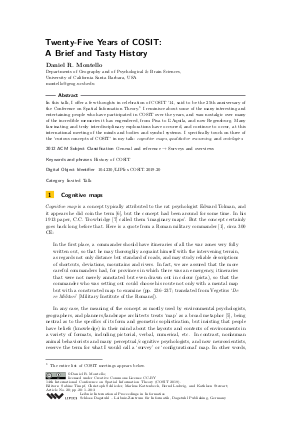Twenty-Five Years of COSIT: A Brief and Tasty History (Invited Talk)
Author Daniel R. Montello
-
Part of:
Volume:
14th International Conference on Spatial Information Theory (COSIT 2019)
Part of: Series: Leibniz International Proceedings in Informatics (LIPIcs)
Part of: Conference: Conference on Spatial Information Theory (COSIT) - License:
 Creative Commons Attribution 3.0 Unported license
Creative Commons Attribution 3.0 Unported license
- Publication Date: 2019-09-03
File

PDF
LIPIcs.COSIT.2019.20.pdf
- Filesize: 277 kB
- 3 pages
Document Identifiers
Subject Classification
ACM Subject Classification
- General and reference → Surveys and overviews
Keywords
- History of COSIT
Metrics
- Access Statistics
-
Total Accesses (updated on a weekly basis)
0PDF Downloads0Metadata Views
Abstract
In this talk, I offer a few thoughts in celebration of COSIT '14, said to be the 25th anniversary of the Conference on Spatial Information Theory. I reminisce about some of the many interesting and entertaining people who have participated in COSIT over the years, and wax nostalgic over many of the incredible memories it has engendered, from Pisa to L’Aquila, and now Regensburg. Many fascinating and truly interdisciplinary explorations have occurred, and continue to occur, at this international meeting of the minds and bodies and symbol systems. I specifically touch on three of the "curious concepts of COSIT" in my talk: cognitive maps, qualitative reasoning, and ontologies.
Cite As Get BibTex
Daniel R. Montello. Twenty-Five Years of COSIT: A Brief and Tasty History (Invited Talk). In 14th International Conference on Spatial Information Theory (COSIT 2019). Leibniz International Proceedings in Informatics (LIPIcs), Volume 142, pp. 20:1-20:3, Schloss Dagstuhl – Leibniz-Zentrum für Informatik (2019)
https://doi.org/10.4230/LIPIcs.COSIT.2019.20
BibTex
@InProceedings{montello:LIPIcs.COSIT.2019.20,
author = {Montello, Daniel R.},
title = {{Twenty-Five Years of COSIT: A Brief and Tasty History}},
booktitle = {14th International Conference on Spatial Information Theory (COSIT 2019)},
pages = {20:1--20:3},
series = {Leibniz International Proceedings in Informatics (LIPIcs)},
ISBN = {978-3-95977-115-3},
ISSN = {1868-8969},
year = {2019},
volume = {142},
editor = {Timpf, Sabine and Schlieder, Christoph and Kattenbeck, Markus and Ludwig, Bernd and Stewart, Kathleen},
publisher = {Schloss Dagstuhl -- Leibniz-Zentrum f{\"u}r Informatik},
address = {Dagstuhl, Germany},
URL = {https://drops.dagstuhl.de/entities/document/10.4230/LIPIcs.COSIT.2019.20},
URN = {urn:nbn:de:0030-drops-111120},
doi = {10.4230/LIPIcs.COSIT.2019.20},
annote = {Keywords: History of COSIT}
}
Author Details
References
-
O. A. W. Dilke. Itineraries and geographical maps in the early and late Roman empires. In J. B. Harley and David Woodward, editors, The History of Cartography, Volume 1: Cartography in Prehistoric, Ancient, and Medieval Europe and the Mediterranean, pages 234-257. The University of Chicago Press, Chicago, 1987.

-
Andrew U. Frank. Spatial ontology: A geographical information point of view. In Oliviero Stock, editor, Spatial and Temporal Reasoning, pages 135-153, Dordrecht, The Netherlands, 1997. Springer.

-
Christian Freksa. Using orientation information for qualitative spatial reasoning. In Andrew U. Frank, Irene Campari, and Ubaldo Formentini, editors, Theories and Methods of Spatio-Temporal Reasoning in Geographic Space, volume 639 of Lecture Notes in Computer Science, pages 162-178, Berlin, Heidelberg, 1992. Springer.

-
Werner Kuhn. Core concepts of spatial information for transdisciplinary research. International Journal of Geographical Information, 26(12):2267-2276, 2012.

-
Daniel R. Montello and Scott M. Freundschuh. Sources of spatial knowledge and their implications for GIS: An Introduction. Geographical Systems, 2:169-176, 1995.

-
Edward C. Tolman. Cognitive maps in rats and men. The Psychological Review, 55(4):189-208, 1948.

-
C. C. Trowbridge. On fundamental methods of orientation and "imaginary maps". Science, New Series, 38(990):888-897, 1913.

